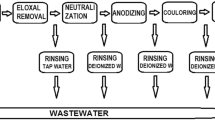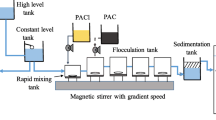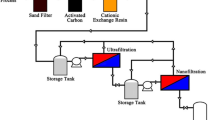Abstract
It is reported that residual aluminum from coagulation pretreatment can increase membrane fouling in nanofiltration (NF) or reverse osmosis (RO) desalination systems. However, the membrane fouling mechanism of residual aluminum and the effective control measures are not very clear. In this study, the nanofiltration membrane fouling caused by poly-aluminum chloride (PACl), the inhibitory effect of amino trimethylene phosphonic acid (ATMP) on aluminum foulants, and calcium carbonate scale in the presence of residual aluminum were investigated by permeate experiments and scanning electron microscopy (SEM) observation of the fouled membranes. Besides, the effect of adding ultrafiltration before nanofiltration on reducing membrane fouling caused by residual aluminum was also investigated. The results showed that most of the residual aluminum in feed eventually formed insoluble particles and fine flocs, and accumulated gradually on the membrane surface, which was a typical colloid particle fouling. ATMP can reduce the membrane fouling caused by residual aluminum to some extent, and the permeate flux ratio (J/Jc) increased from 0.83 to 0.89 when ATMP increased to the optimal dose of 6 mg⋅L−1. However, this means can still effectively eliminate carbonate scale, even in the presence of residual aluminum. Moreover, ultrafiltration pretreatment prior to nanofiltration was very effective to control membrane fouling, and the comprehensive cost was calculated to be only 0.006 $⋅m−3. Therefore, the combined process of coagulation-ultrafiltration as a pretreatment of nanofiltration or reverse osmosis should be an ideal way to prevent membrane fouling caused by residual aluminum.








Similar content being viewed by others
Data Availability
The data that support the findings of this study are available on request from the corresponding author Xian-Qiu Zhang. The data are not publicly available due to them containing information that could compromise research participant consent.
References
Ali, S. A., Kazi, I. W., & Rahman, F. (2015). Synthesis and evaluation of phosphate-free antiscalants to control CaSO4·2H2O scale formation in reverse osmosis desalination plants. Desalination, 357(2), 36–44. https://doi.org/10.1016/j.desal.2014.11.006
Ang, W. L., Mohammad, A. W., Hilal, N., & Leo, C. P. (2015). A review on the applicability of integrated/hybrid membrane processes in water treatment and desalination plants. Desalination, 363(1), 2–18. https://doi.org/10.1016/j.desal.2014.03.008
Ang, W. L., Mohammad, A. W., Benamor, A., & Hilal, N. (2016a). Hybrid coagulation–NF membrane processes for brackish water treatment: Effect of pH and salt/calcium concentration. Desalination, 390(15), 25–32. https://doi.org/10.1016/j.desal.2016.03.018
Ang, W. L., Mohammad, A. W., Benamor, A., Hilal, N., & Leo, C. P. (2016b). Hybrid coagulation-NF membrane process for brackish water treatment: Effect of antiscalant on water characteristics and membrane fouling. Desalination, 393(1), 144–150. https://doi.org/10.1016/j.desal.2016.01.010
Ayoub, G. M., Korban, L., Al-Hindi, M., & Zayyat, R. (2019). Brackish water desalination: An effective pretreatment process for reverse osmosis systems. Water Air and Soil Pollution, 230, 238. https://doi.org/10.1007/s11270-019-4299-2
Bruggen, B., & Vandecasteele, C. (2003). Removal of pollutants from surface water and groundwater by nanofiltration: Overview of possible applications in the drinking water industry. Environmental Pollution, 122(3), 435–445. https://doi.org/10.1016/S0269-7491(02)00308-1
Butt, F. H., Rahman, F., & Baduruthamal, U. (1997). Characterization of foulants by autopsy of ro desalination membranes. Desalination, 114(1), 51–64. https://doi.org/10.1016/S0011-9164(97)00154-9
Choi, Y. H., Nason, J. A., & Kweon, J. H. (2013). Effects of aluminum hydrolysis products and natural organic matter on nanofiltration fouling with PACl coagulation pretreatment - sciencedirect. Separation and Purification Technology, 120(13), 78–85. https://doi.org/10.1016/j.seppur.2013.09.016
Fan, G. D., Li, Z. S., Yan, Z. S., Wei, Z. Q., Xiao, Y. G., Chen, S. B., et al. (2020). Operating parameters optimization of combined UF/NF dual-membrane process for brackish water treatment and its application performance in municipal drinking water treatment plant. Journal of Water Process Engineering, 38, 101547. https://doi.org/10.1016/j.jwpe.2020.101547
Gabelich, C. J., Yun, T. I., Coffey, B. M., & Suffet, I. H. (2002). Effects of aluminum sulfate and ferric chloride coagulant residuals on polyamide membrane performance. Desalination, 150(1), 15–30. https://doi.org/10.1016/S0011-9164(02)00926-8
Gabelich, C. J., Chen, W. R., Yun, T. I., Coffey, B. M., & Suffet, I. H. (2005). The role of dissolved aluminum in silica chemistry for membrane processes. Desalination, 180(1–3), 307–319. https://doi.org/10.1016/j.desal.2005.02.009
Gabelich, C. J., Ishida, K. P., Gerringer, F. W., Evangelista, R., Kalyan, M., & Suffet, I. H. (2006). Control of residual aluminum from conventional treatment to improve reverse osmosis performance. Desalination, 190(1–3), 147–160. https://doi.org/10.1016/j.desal.2005.09.002
Gácsi, A., Kutus, B., Kónya, Z., Kukovecz, Á., Pálinkó, I., & Sipos, P. (2016). Estimation of the solubility product of hydrocalumite–hydroxide, a layered double hydroxide with the formula of [Ca2Al(OH)6]OH·nH2O. Journal of Physics and Chemistry of Solids, 98, 167–173. https://doi.org/10.1016/j.jpcs.2016.07.004
Ghafour, E. (2003). Enhancing RO system performance utilizing antiscalants. Desalination, 153(1), 149–153. https://doi.org/10.1016/S0011-9164(02)01117-7
Greenlee, L. F., Testa, F., Lawler, D. F., Freeman, B. D., & Moulin, P. (2010). The effect of antiscalant addition on calcium carbonate precipitation for a simplified synthetic brackish water reverse osmosis concentrate. Water Research, 44(9), 2957–2969. https://doi.org/10.1016/j.watres.2010.02.024
Han, X., Zhang, X. Q., Yang, S. Q., & Du, M. X. (2019). The effects of scale inhibitor ATMP in water on nanofiltration. Desalination and Water Treatment, 160, 9–13. https://doi.org/10.5004/dwt.2019.24378
Ji, Y., Chen, Y., Le, J. X., Qian, M. Q., Huan, Y., Yang, W. Z., et al. (2017). Highly effective scale inhibition performance of amino trimethylenephosphonic acid on calcium carbonate. Desalination, 422(15), 165–173. https://doi.org/10.1016/j.desal.2017.08.027
Li, X. C., Gao, B. Y., Yue, Q. Y., Ma, D. F., Rong, H. Y., Zhao, P., et al. (2015). Effect of six kinds of scale inhibitors on calcium carbonate precipitation in high salinity wastewater at high temperatures. Journal of Environmental Sciences, 29(003), 124–130. https://doi.org/10.1016/j.jes.2014.09.027
Lin, D. C., Yan, Z. S., Tang, X. B., Wang, J. L., Liang, H., & Li, G. B. (2019). Inorganic coagulant induced gypsum scaling in nanofiltration process: Effects of coagulant concentration, coagulant conditioning time and fouling strategies. Science of the Total Environment, 670(20), 685–695. https://doi.org/10.1016/j.scitotenv.2019.03.266
Listiarini, K., Tor, J. T., Sun, D. D., & Leckie, J. O. (2010). Hybrid coagulation-nanofiltration membrane for removal of bromate and humic acid in water. Journal of Membrane Science, 365(1–2), 154–159. https://doi.org/10.1016/j.memsci.2010.08.048
Madsen, H. T., Ammi-said, A., Bruggen, B., & Søgaard, E. K. (2015). Addition of adsorbents to nanofiltration membrane to obtain complete pesticide removal. Water Air and Soil Pollution, 226, 160. https://doi.org/10.1007/s11270-015-2419-1
Mänttäri, M., Pihlajamäki, A., & Nyström, M. (2006). Effect of pH on hydrophilicity and charge and their effect on the filtration efficiency of NF membranes at different pH. Journal of Membrane Science, 280(1–2), 311–320. https://doi.org/10.1016/j.memsci.2006.01.034
Ohno, K., Matsui, Y., Itoh, M., Oguchi, Y., Kondo, T., Konno, Y., et al. (2010). NF membrane fouling by aluminum and iron coagulant residuals after coagulation-MF pretreatment. Desalination, 254(1–3), 17–22. https://doi.org/10.1016/j.desal.2009.12.020
Shih, W. Y., Gao, J., Rahardianto, A., Glater, J., Cohen, Y., & Gabelich, C. J. (2006). Ranking of antiscalant performance for gypsum scale suppression in the presence of residual aluminum. Desalination, 196(1–3), 280–292. https://doi.org/10.1016/j.desal.2006.04.001
Yang, L. Y., She, Q. H., Wan, M. P., Wang, R., Chang, W. C., & Tang, C. Y. (2017). Removal of haloacetic acids from swimming pool water by reverse osmosis and nanofiltration. Water Research, 116(1), 116–125. https://doi.org/10.1016/j.watres.2017.03.025
Yu, Y., Zhao, C. W., Yu, L., Li, P., Wang, T., & Xu, Y. (2016). Removal of perfluorooctane sulfonates from water by a hybrid coagulation-nanofiltration process. Chemical Engineering Journal, 289(1), 7–16. https://doi.org/10.1016/j.cej.2015.12.048
Zeino, A., Albakri, M., Khaled, M., & Zarzour, M. (2018). Comparative study of the synergistic effect of ATMP and DTPMPA on CaSO4 scale inhibition and evaluation of induction time effect. Journal of Water Process Engineering, 21, 1–8. https://doi.org/10.1016/j.jwpe.2017.11.013
Zeng, C., Tanaka, S., Suzuki, Y., & Fujii, S. (2017). Impact of feed water pH and membrane material on nanofiltration of perfluorohexanoic acid in aqueous solution - sciencedirect. Chemosphere, 183, 599–604. https://doi.org/10.1016/j.chemosphere.2017.05.132
Zhang, J. D., Zeng, H. M., Ye, C. S., Chen, L., & Yan, X. X. (2008). Pilot test of UF pretreatment prior to RO for cooling tower blowdown reuse of power plant. Desalination, 222(1–3), 9–16. https://doi.org/10.1016/j.desal.2007.01.123
Zhang, X. Q., Han, X., Zhang, X., Yang, S. Q., & Du, M. X. (2020). A partial feed nanofiltration system with stabilizing water quality for treating the sewage discharged from open recirculating cooling water systems. Separation and Purification Technology, 234(1), 116045. https://doi.org/10.1016/j.seppur.2019.116045
Funding
This work was financially supported by National Water Pollution Control and Treatment Science and Technology Major Project (2017ZX07202-004).
Author information
Authors and Affiliations
Corresponding author
Ethics declarations
Conflict of Interest
The authors declare no competing interests.
Additional information
Publisher's Note
Springer Nature remains neutral with regard to jurisdictional claims in published maps and institutional affiliations.
Rights and permissions
About this article
Cite this article
Yu, HB., Zhang, XQ., Han, X. et al. Nanofiltration Membrane Fouling and Control Caused by Residual Aluminum in Feed Water. Water Air Soil Pollut 233, 1 (2022). https://doi.org/10.1007/s11270-021-05470-z
Received:
Accepted:
Published:
DOI: https://doi.org/10.1007/s11270-021-05470-z




